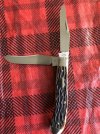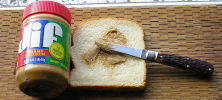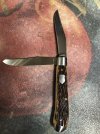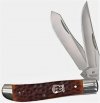- Joined
- Dec 1, 2016
- Messages
- 11,069
If you had asked me last year and likely the preceding years, I would have stated that the Jack (in the configuration mentioned in the OP) reigns supreme in my mind. I've always preferred at least two blades on my slip joints and the regular Jack has typically suited my needs just fine - particularly if the secondary was straight edged like a coping blade.
Having a robust Spear or Clip main, paired with a slim coping blade is a recipe for the ideal knife in my mind. The only exception to this rule would be a Lambsfoot (single blade configuration) - it is the only knife that I never feel wanting for a secondary blade as the Lambsfoot proves singularly useful in all tasks short of skinning an animal and spreading peanut butter.

The classic trapper blade configuration has never held great appeal for me. I generally have little use for a spey blade and therefore it would rarely get used, if at all. My dad would use the spey blade on his stockman knives to turn screws on the farm - as such, it was usually the first blade to break on his knives (good thing there were two others to choose from after the fact ).
).
That said though, I found appeal in the recent runs of 73s and 23s - the frame is comfortable, the overall package remains pocketable (73), and the spey blade on these is broad, with lots of belly, and thinly ground which lends itself well to more food related tasks. I haven't taken the opportunity to give any of these a proper workout yet but they will be there when the itch needs scratching.

Curiously enough, the last M&G offering is called "The Trapper", modelled after the "Indian Trapper" in an old M&G advert, if memory serves. These are definitely not in any Trapper configuration as we have so far defined (they are Jacks rather) but it is interesting to see a departure from the commonly accepted norms in terminology.
(Please pardon the blue sky being reflected in a rather polished blade)

Then we have this monstrosity. Another M&G offering (Queen made, if I recall, and it most definitely shows...), this one is more accurately called a folding Hunter but it is in a rarer 2-blade configuration with a fat spear blade that could take care of skinning chores with reasonable ease (if it were ground correctly ). This must be for trapping those R.O.U.S. - bonus points for those who know what those are
). This must be for trapping those R.O.U.S. - bonus points for those who know what those are  .
.

Now we come to the knife and configuration that has upended my preferences up to this point something fierce - the Wharncliffe Trapper. I've only recently come into these but the Case/Bose collab has been in my pocket more than any other this year so far. I think I like the additional length in the GEC Improved Trappers better but the robust construction of the Case/Bose has kept me from giving them their due as of now. It is why I would really like to find a Case/Bose slimline Trapper - I think I'd take to that knife in a heartbeat.
I am not usually a "flavor of the day" sort of guy so I suspect my fondness for the WT is going to persist for a good long time, if not indefinitely. It's why I am rather excited for GEC's debut of the 88 - instead of a Wharncliffe Trapper, it is a Lambsfoot Trapper and if GEC executes it well, it stands to become a fast favorite.

Having a robust Spear or Clip main, paired with a slim coping blade is a recipe for the ideal knife in my mind. The only exception to this rule would be a Lambsfoot (single blade configuration) - it is the only knife that I never feel wanting for a secondary blade as the Lambsfoot proves singularly useful in all tasks short of skinning an animal and spreading peanut butter.

The classic trapper blade configuration has never held great appeal for me. I generally have little use for a spey blade and therefore it would rarely get used, if at all. My dad would use the spey blade on his stockman knives to turn screws on the farm - as such, it was usually the first blade to break on his knives (good thing there were two others to choose from after the fact
That said though, I found appeal in the recent runs of 73s and 23s - the frame is comfortable, the overall package remains pocketable (73), and the spey blade on these is broad, with lots of belly, and thinly ground which lends itself well to more food related tasks. I haven't taken the opportunity to give any of these a proper workout yet but they will be there when the itch needs scratching.

Curiously enough, the last M&G offering is called "The Trapper", modelled after the "Indian Trapper" in an old M&G advert, if memory serves. These are definitely not in any Trapper configuration as we have so far defined (they are Jacks rather) but it is interesting to see a departure from the commonly accepted norms in terminology.
(Please pardon the blue sky being reflected in a rather polished blade)

Then we have this monstrosity. Another M&G offering (Queen made, if I recall, and it most definitely shows...), this one is more accurately called a folding Hunter but it is in a rarer 2-blade configuration with a fat spear blade that could take care of skinning chores with reasonable ease (if it were ground correctly

Now we come to the knife and configuration that has upended my preferences up to this point something fierce - the Wharncliffe Trapper. I've only recently come into these but the Case/Bose collab has been in my pocket more than any other this year so far. I think I like the additional length in the GEC Improved Trappers better but the robust construction of the Case/Bose has kept me from giving them their due as of now. It is why I would really like to find a Case/Bose slimline Trapper - I think I'd take to that knife in a heartbeat.
I am not usually a "flavor of the day" sort of guy so I suspect my fondness for the WT is going to persist for a good long time, if not indefinitely. It's why I am rather excited for GEC's debut of the 88 - instead of a Wharncliffe Trapper, it is a Lambsfoot Trapper and if GEC executes it well, it stands to become a fast favorite.







